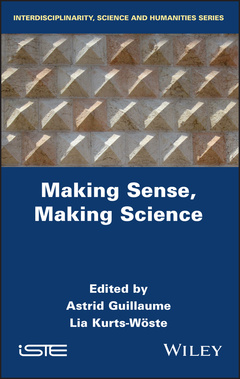Making Sense, Making Science
Coordonnateurs : Guillaume Astrid, Kurts-Wöste Lia

Preface ix
Astrid GUILLAUME and Lia KURTS-WÖSTE
Introduction xxix
François RASTIER
Part 1. Semiotic Foundations of the Cultural Sciences 1
Chapter 1. Cassirer and Symbolic Forms 3
Jean LASSÈGUE
1.1. Unity and diversity of modes of objectification 3
1.1.1. Modes of objectification in the transcendental tradition 3
1.1.2. The geometric objectification crisis 5
1.2. The harmonics of forms: internalization and exportation 8
1.2.1. Interdisciplinarity of the transformation group concept 8
1.2.2. Beyond the transformation group 10
1.3. From the social sciences to the natural sciences and back again: the example of statistics 12
1.3.1. The internal historical transformation of the statistical paradigm 13
1.3.2. Back to social sciences 15
1.4. Conclusion 15
1.5. References 15
Chapter 2. Leroi-Gourhan and the Birth of the Symbolic Function 17
Arild UTAKER
2.1. The image of man 17
2.2. The human body 20
2.3. The hand and the tool 23
2.4. Technique and language 25
2.5. Language and visualization 28
2.6. Memory and history 31
2.7. Conclusion 33
2.8. References 34
Chapter 3. Simondon, Language and Technology 35
Vincent BONTEMS
3.1. The precedence of technology over language 36
3.2. Simondon’s technological vocabulary 38
3.3. For a diagram of the technical lineages 39
3.4. Conclusion 41
3.5. References 42
Part 2. Hermeneutics of Science, Hermeneutical Sciences 45
Chapter 4. On the Philosophy of Mathematics: Reflections on “Making Science”, Based on Cavaillès 47
Franck NEVEU
4.1. Mathematics, a precondition of rational philosophy 47
4.2. Reasoning by the absurd and excluded middle 49
4.3. The final causes 50
4.4. “Universally true” judgments 51
4.5. The linguistic problem of mathematics 52
4.6. The epistemological break: the explanatory versus comprehensive method 53
4.7. The understanding 54
4.8. Mathematics as becoming 56
4.9. Truth and metalanguage 58
4.10. The theoretical in difficulty, an aspect of the epistemological shift in linguistics 59
4.11. References 61
Chapter 5. The Semiotic Articulation of Textual Meaning: Significance, Signification, Designation and Expression 63
Régis MISSIRE
5.1. The articulation of meaning according to three semiotic relations: signification, designation and expression 65
5.1.1. The relation of signification 65
5.1.2. Designation 67
5.1.3. Relation of expression 68
5.2. Significance and meaning 70
5.2.1. Significance and signification 71
5.2.2. Significance and designation 74
5.2.3. Significance and expression 76
5.3. References 78
Chapter 6. Semiotics of Cultures and Theoretical Hybridities: For a Renewal of Thought 81
Astrid GUILLAUME
6.1. Theories: cultural objects in transfer 83
6.2. Definitional reminder 85
6.3. Status of the arts and religious sciences 87
6.4. Geometric plasticity of theories 88
6.5. Theorists and the evolution of theories 92
6.6. Polysemy of cultural fact and scientific rigor 94
6.7. The return of diachrony 95
6.8. Conclusion 95
6.9. References 96
Part 3. Literature and Arts Sciences 101
Chapter 7. Challenges of Non-logocentric Semiotics of Cultures: Explorations Based on Music and the Notion of Significativity 103
Lia KURTS-WÖSTE
7.1. Interpretative action, hermeneutic science and the general hermeneutization of the sciences 104
7.2. Hermeneutics of non-verbal objects: a challenge for the semiotics of cultures, a benefit for thinking about the reinsertion of a theory of meaning into a theory of stakes 111
7.3. Significativity 117
7.4. Music and the hermeneutics of significativity 119
7.5. Modal hermeneutics and engagement strategy 124
7.6. Science of the arts and the esthetic intention of the semiotics of cultures 127
7.7. References 129
Chapter 8. The Roles of a Semiotics of the Arts: Working Hypotheses for Overcoming the Shortcomings of the Past 131
Pierluigi BASSO-FOSSALI
8.1. Some remedies for previous theoretical abuses 131
8.1.1. Partial approaches, all powerful 131
8.1.2. A hermeneutic paradigm for a semiotic ecology 133
8.1.3. Skepticism and responsive aptitude 135
8.2. Some remedies for the universalization brought about by postmodernism 137
8.2.1. A non-ethnocentric aesthetics 137
8.2.2. The (un)manageable nature of primitive art 139
8.2.3. In search of a meaningful place 142
8.3. Some remedies to institutionalized nominalism of art 145
8.3.1. Art as a displayed vulnerability of institutions: maestria in minor mode 146
8.3.2. Art as a fracture of proximity 147
8.3.3. Allopathic regime and the vulnerability of art 148
8.4. Some methodological remedies 150
8.4.1. The work and its spaces of relevance 150
8.4.2. Cultural identity between analysis and interpretation 152
8.4.3. Methodology and knowing anew 153
8.5. References 155
Conclusion 159
Bernard REBER
List of Authors 179
Index 181
Astrid GUILLAUME, Associate Professor Sorbonne Université.
Lia KURTS-WÖSTE, Assistant Professor Université Bordeaux-Montaigne.
Date de parution : 12-2020
Ouvrage de 240 p.
1x1 cm
